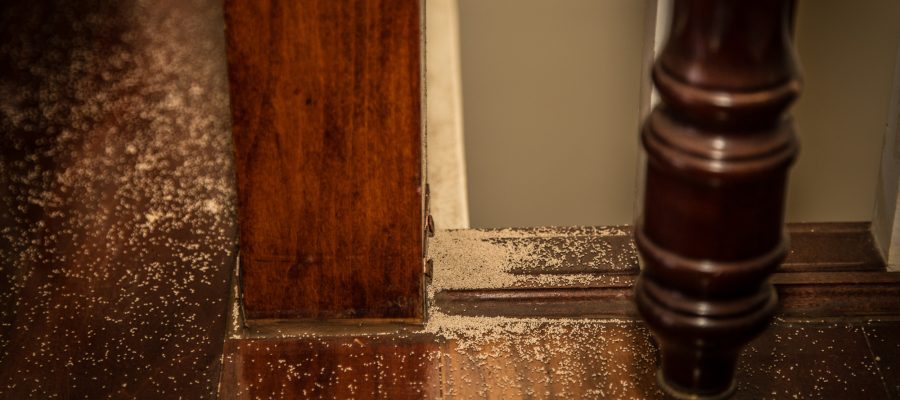7 Small Signs of a Big Termite Problem
- May 20, 2022
- in How To Identify Termites
- by Ashley Dando

Did you know that bugs cost us exactly $600 million yearly in repair and damages?
Among these, the termite is the number one and the most expensive home offender. A single termite problem can cost the home owner far more than, say, a simple bed bug problem.
The high repair cost is often due to damages caused by the late discovery of the termite problem. So, if you want to avoid a costly repair, early detection of termite infestation is vital.
Here are seven minor but sure signs of termite infestation to look out for!
Like adult humans, termites leave their nest to start a new colony when they mature. Termites swarm together, either inside or outside your home, before taking their flight. Soon after winged termites take their flight, they shed their wings, which pile on the ground.
If you see wings resembling fish scales, request for termite inspection immediately. Often, termite wings indicate a long-term colony of termites living in your home.
Subterranean termites are the most common type of pest found throughout Australia. These pests like to build colonies underground and only go aboveground for food. They can enter your home through unsealed or cracked foundations and mud tubes.
Subterranean termites use their feces, saliva, mud, and debris to make tunnels. These tunnels are brown and cylindrical appearance-wise.
Termites also use these tunnels to travel. They serve as a shield from predators as well as to keep moisture away. Thus, if you spot vein-like mud tubes anywhere in your home, call a local termite control company.
An obvious indicator that you have a termite problem is the presence of termites themselves. Termites often leave their nest to find mates before establishing a new colony. Thus, if you see flying termites near or in your home, it usually indicates two things.
First, there’s an established colony of termites inside or near your home where the mature termites came from. Second, if there isn’t one, it’s likely that a new colony will form soon. This is because after flying termites find a mate, they’ll crawl to a nearby nesting site.
Termites will seal themselves in and start making their colony for as long as ten years. Hence, every nearby home becomes a prospective site for termite infestation.
When you knock on wood in your home that sounds papery, start looking for termite treatment options. This is because the wood inside was already eaten away by termites.
Speaking of sounds, ever wondered how termites sound? Termite soldiers make quite clicking sounds, especially when they’re disturbed.
Soldier termites alarm the rest of the colony when they sense disturbance or danger. They do so by banging their heads against the wood to signal danger hence, the sound.
Meanwhile, worker termites are those that eat away the wood in your home. These pests are some of the nosiest eaters around. If you put your ear to a wood structure and you hear munching sounds, that’s them hard at work.
If there are any broken pieces of wood in your home, check to see if there are galleries in them. Galleries are tunneling that termites make when they consume wood inside out.
If you see them on broken wood, it’s a sure sign that colonies of termites are residing in your home. They’ve finished eating away that wood and are currently eating another in your home. You need to get termite treatment to stop them from further destroying your wood fixtures.
However, finding galleries in intact wood is a much harder task. The good news is that various technologies such as borescopes, X-rays, and infrared detectors are easily accessible. These are some of the most popular technologies that one can use to detect galleries when there are no visible signs.
It’s easy to mistake termites as white ants since both creatures are similar in size, shape, and even behavior. However, ants are very different from termites in so many ways.
Compared to ants, termites have a lighter color, often lighter to the point that they can look translucent. The antennae of termites are also straight and not elbowed like ants.
Both ants and termites can have wings, but the wings of termites are similar sizes. On the other hand, ants have a set of wings whereby one is always larger than the other. Another contrast between the two is the area where the thorax and abdomen meet is larger for termites than in ants.
Yet, the most important thing to note is that white ants don’t exist. Termites are often termed white ants, but such creatures don’t exist. Hence, if you spot something that looks like white ants, it might be a termite.
If you were a termite, would you leave a house full of a free all-you-can-eat wood buffet? Once termites find a place they like, they will stay until they’ve finished off all the food. Unless you take action, you’ll keep feeding these little pests for years.
Don’t wait until the damages become massive. Instead, give us a call the moment you spot small signs of a termite problem at your home! Let our skilled and experienced terminators help preserve your home.